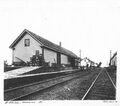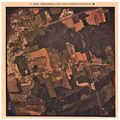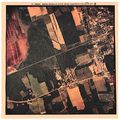Dominion Atlantic Railway Digital Preservation Initiative - Wiki
Use of this site is subject to our Terms & Conditions.
Berwick
Berwick, Nova Scotia
Subdivision Kentville, Mile 12.3
- Next Station East: Waterville
- Next Station West: Aylesford
Description & History
Located on a fertile height of land between the headwaters of the Cornwallis and Annapolis Rivers, Berwick was settled about 1810 when Benjamin Congdon built a farm and a store at a crossroads near a bridge over the upper Cornwallis River. The community was known progressively as the "Congdon Settlement", "Curry's Corner", and "Davison's Corner" after various prominent families. Residents voted in 1851 to chose the name Berwick after the English town of Berwick-upon-Tweed.[1]
Berwick became a station on the Windsor & Annapolis Railway in 1869. The railway soon transformed the small farming crossroads in to a busy town. The station was built one mile south of the village of Berwick and the stop was at first known officially as "Berwick Station" to distinguish it from the village to the north. However the village essentially moved to cluster around the railway. The centre of business moved south to the tracks, away from the original Main Street beside the Cornwallis River. Commercial Street which led to the Berwick Station became the new centre of town. Two new streets grew beside the train tracks. Behind the station, a series of mills opened along Mill Street which grew on the north side of the tracks. Next, Front Street evolved along the south side of the tracks to serve the apple industry. A large export market for apples developed led by ambitious growers such as S. B. Chute, F. B. Parker and several apple co-operatives such as Berwick Fruit. All built warehouses around the station and along Front Street which was built to serve the biggest warehouses and packing plants on the south side of the tracks. The railway also attracted spin-off industries such as the Berwick Evaporator, the fruit processor M.W. Graves and the Berwick Bakery, all served by dedicated rail spurs. Thanks to this growth, Berwick officially became a town in 1923.[2] Berwick had rail service until Canadian Pacific abandoned the Dominion Atlantic tracks in March 1990. Today the DAR tracks are a popular multi-use recreational trail. The Apple Capital Museum located on Commercial Street next to the former DAR tracks has a large 1:87 scale diorama of the Berwick railyards and warehouses representing the DAR in golden age of apple exports.
Facilities & Features
- Berwick Station
- Passing track, 1728 feet long, just east of Foster Street level crossing
Commerce & Industry
- Berwick Fruit cooperative apple warehouse
- F. B. Parker apple warehouse
- Berwick Evaporator
- S. B. Chute Mill Street apple warehouse
- S. B. Chute Front Street apple warehouse
- Pleasant Valley apple warehouse
- P. L. Morse apple warehouse
- Brazilian Fruit apple warehouse
- Imperial Oil Bulk Fuels
- M. W. Graves Food Processing
- Berwick Bakery
Gallery
Berwick Station during the apple export season before apple warehouses were built, 1890s.
Berwick Station, Oct. 5, 1910.
The Pleasant Valley apple warehouse, just after construction with the rear of the Berwick Station to right, 1911.
Plans of the Pleasant Valley apple warehouse, as built, 1910, drawn by Dan Conlin, 2004.
Berwick Fruit, the first co-operative apple warehouse, featured in Farmer's Magazine, January-December 1915.
Berwick Station with the Pleasant Valley apple warehouse in background, Feb. 1916 or winter 1917.
"Berwick, showing Berwick Fruit; S. B. Chute Front St,, Hutchinson Mill, Berwick Station, H.C Mosher, and the S.B. Chute Mill St. warehouses, circa 1919.
Berwick Evaporator soon after construction with spur, boxcars and other buildings on Front Street, circa 1919.
The 2nd Berwick Fruit co-operative apple warehouse, largest apple warehouse in the Maritimes, 1935.
M. W. Graves Plant, Berwick. c. 1940.
Berwick Station looking north east with one end of the Pleasant Valley Fruit Company warehouse in the right background, September 1958.
Berwick Station looking west with the Brazilian Packers warehouse in the background, August 15, 1963.
Berwick Station, post 1950s.
Berwick Station, last known photograph of the station, summer or early fall 1973.
Berwick, looking east with station just demolished on left and Berwick Fruit on right, 1975.
A digital model screen shot of Berwick circa 1975 on the Microsoft Train Simulator DAR Route authored by Paul Charland
Canadian National insulated boxcar 291735 which rolled out of control from the Berwick Bakery spur and coasted downgrade to Waterville, circa 1980.
VIA Berwick shelter, with cylindrical hopper on spur, April 1986.
Residents of Berwick gather to witness the last eastbound passenger train at the at the Berwick Station, January 14, 1990.
Article about the Berwick Evaporator, 2006.
M. W. Graves former plant, Berwick, 2016.
Berwick, 1977.
Berwick, 1977.
Berwick, 1977.
References & Footnotes
- Alexander MacNab, Windsor and Annapolis Railway, Report of Alexander MacNab Nov 1, 1873
- 1969 Memorandum of General Information, "Berwick" p. 10
- ↑ C. Bruce Fergusson, "Berwick", Place-Names and Places of Nova Scotia Nova Scotia Archives (1967), p. 57-58
- ↑ Ron Illsley, Berwick (2008)





























